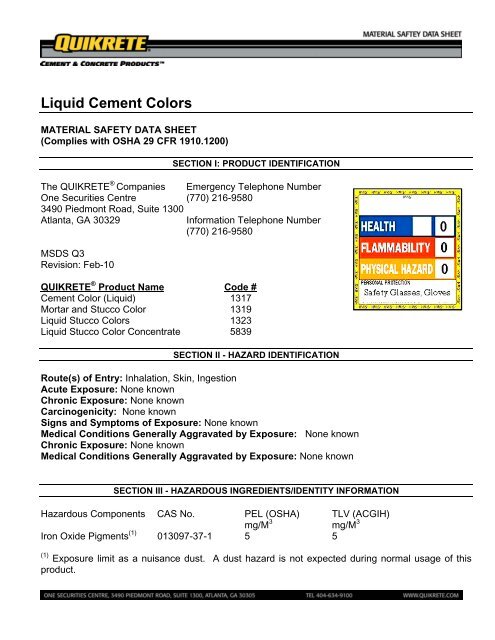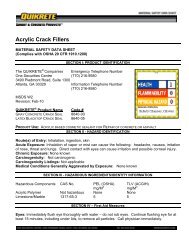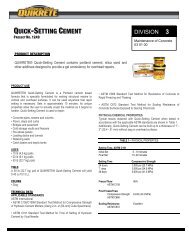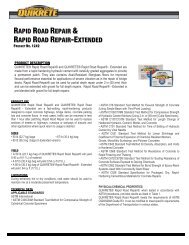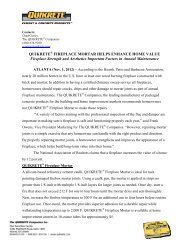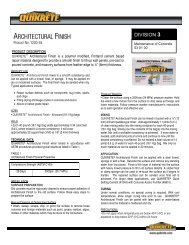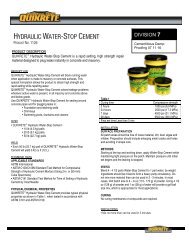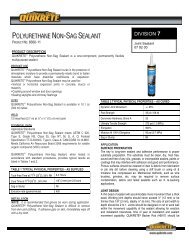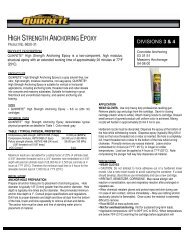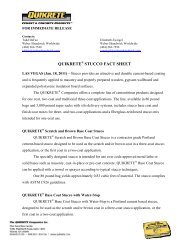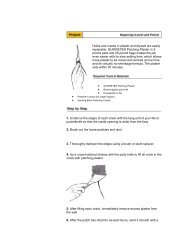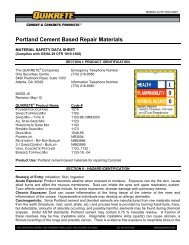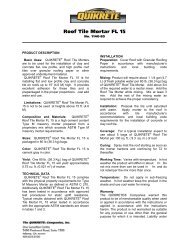Liquid Cement Colors
Liquid Cement Colors - Quikrete
Liquid Cement Colors - Quikrete
You also want an ePaper? Increase the reach of your titles
YUMPU automatically turns print PDFs into web optimized ePapers that Google loves.
<strong>Liquid</strong> <strong>Cement</strong> <strong>Colors</strong>MATERIAL SAFETY DATA SHEET(Complies with OSHA 29 CFR 1910.1200)SECTION I: PRODUCT IDENTIFICATIONThe QUIKRETE ® Companies Emergency Telephone NumberOne Securities Centre (770) 216-95803490 Piedmont Road, Suite 1300Atlanta, GA 30329Information Telephone Number(770) 216-9580MSDS Q3Revision: Feb-10QUIKRETE ® Product Name Code #<strong>Cement</strong> Color (<strong>Liquid</strong>) 1317Mortar and Stucco Color 1319<strong>Liquid</strong> Stucco <strong>Colors</strong> 1323<strong>Liquid</strong> Stucco Color Concentrate 5839SECTION II - HAZARD IDENTIFICATIONRoute(s) of Entry: Inhalation, Skin, IngestionAcute Exposure: None knownChronic Exposure: None knownCarcinogenicity: None knownSigns and Symptoms of Exposure: None knownMedical Conditions Generally Aggravated by Exposure: None knownChronic Exposure: None knownMedical Conditions Generally Aggravated by Exposure: None knownSECTION III - HAZARDOUS INGREDIENTS/IDENTITY INFORMATIONHazardous Components CAS No. PEL (OSHA) TLV (ACGIH)mg/M 3 mg/M 3Iron Oxide Pigments (1) 013097-37-1 5 5(1) Exposure limit as a nuisance dust. A dust hazard is not expected during normal usage of thisproduct.
SECTION IV – First Aid MeasuresEyes: Immediately flush eye thoroughly with water. Continue flushing eye for at least 15 minutes,including under lids, to remove all particles. Call physician immediately.Skin: Wash skin with cool water and pH-neutral soap or a mild detergent. Seek medical treatment ifirritation or inflammation develops or persists. Seek immediate medical treatment in the event ofburns.Inhalation: Remove person to fresh air. If breathing is difficult, administer oxygen. If not breathing,give artificial respiration. Seek medical help if coughing and other symptoms do not subside.Ingestion: Contact a physician immediately.SECTION V - FIRE AND EXPLOSION HAZARD DATAFlammability: Noncombustible and not explosive.Auto-ignition Temperature: Not ApplicableFlash Points: Not ApplicableSECTION VI – ACCIDENTAL RELEASE MEASURESIf spilled, use common housekeeping, vacuum or scoop material into a container for reclamation ordisposal.SECTION VII - PRECAUTIONS FOR SAFE HANDLING AND STORAGEGeneral housekeeping requirements should be followed. Keep containers sealed to preserveproduct utility.Engineering Controls: General ventilationSECTION VIII – EXPOSURE CONTROL MEASURESPersonal Protection: Protective gloves and eyewear are recommended. Ordinary work/hygienepractices should be followed.Exposure Limits: Consult local authorities for acceptable exposure limits.SECTION IX - PHYSICAL/CHEMICAL CHARACTERISTICSAppearance:Color:Odor:Melt Point/Freeze Point:Boiling Point:Vapor Pressure:<strong>Liquid</strong>Buff, Tan, Brown, Black, Red (Yellow, stucco colors only)None28 o F160-200 o FNot Known
Specific Gravity: 1.7-1.9Bulk Density:14-16 lb./gallonSolubility in Water:Very slightly% Volatile by Volume: Not KnownSECTION X - REACTIVITY DATAStability: Stable.Incompatibility (Materials to Avoid): NoneHazardous Decomposition or By-products: NoneHazardous Polymerization: Will Not Occur.Routes of Entry: Inhalation, IngestionToxicity to Animals:LD50: Not AvailableLC50: Not AvailableChronic Effects on Humans: None knownSpecial Remarks on Toxicity: Not AvailableSECTION XI – TOXICOLOGICAL INFORMATIONSECTION XII – ECOLOGICAL INFORMATIONEcotoxicity: Not AvailableBOD5 and COD: Not AvailableProducts of Biodegradation: Not availableToxicity of the Products of Biodegradation: Not availableSpecial Remarks on the Products of Biodegradation: Not availableSECTION XIII – DISPOSAL CONSIDERATIONSWaste Disposal Method: Material which cannot be reclaimed should be dried and landfilled inaccordance with local, state and federal regulations. This product is not classified as a hazardouswaste under the authority of the RCRA (40CFR 261) or CERCLA (40CFR 117&302).SECTION XIV – TRANSPORT INFORMATIONDOT/UN Shipping Name: Non-regulatedDOT Hazard Class: Non-regulatedShipping Name: Non-regulatedNon-Hazardous under U.S. DOT and TDG Regulations
SECTION XV – OTHER REGULATORY INFORMATIONUS OSHA 29CFR 1910.1200: Considered hazardous under this regulation and should be includedin the employers hazard communication programSARA (Title III) Sections 311 & 312: Not subject to reporting requirementsSARA (Title III) Section 313: Not subject to reporting requirementsTSCA (May 1997): All components are on the TSCA inventory listFederal Hazardous Substances Act: Is a hazardous substance subject to statues promulgatedunder the subject actCanadian Environmental Protection Act: Not listedCanadian WHMIS: Considered to be a hazardous material under the Hazardous Products Act asdefined by the Controlled Products Regulations and subject to the requirements of WHMIS. Thisproduct has been classified according to the hazard criteria of the Controlled Products Regulation(CPR). This document complies with the WHMIS requirements of the Hazardous Products Act(HPA) and the CPR.SECTION XVI – OTHER INFORMATIONHMIS-III: Health – 0 = No significant health risk1 = Irritation or minor reversible injury possible2 = Temporary or minor injury possible3 = Major injury possible unless prompt action is taken4 = Life threatening, major or permanent damage possibleFlammability- 0 = Material will not burn1 = Material must be preheated before ignition will occur2 = Material must be exposed to high temperatures before ignition3 = Material capable of ignition under normal temperatures4 = Flammable gases or very volatile liquids; may ignite spontaneouslyPhysical Hazard- 0 = Material is normally stable, even under fire conditions1 = Material normally stable but may become unstable at high temps2 = Materials that are unstable and may undergo react at room temp3 = Materials that may form explosive mixtures with water4 = Materials that are readily capable of explosive water reactionAbbreviations:ACGIHCASCERCLACFRCPRDOTIARCMSHANIOSHNTPAmerican Conference of Government Industrial HygienistsChemical Abstract ServiceComprehensive Environmental Response, Compensation & Liability ActCode of Federal RegulationsControlled Products Regulations (Canada)Department of TransportationInternational Agency for ResearchMine Safety and Health AdministrationNational Institute for Occupational Safety and HealthNational Toxicity Program
OSHAPELRCRASARATLVTWAWHMISOccupational Safety and Health AdministrationPermissible Exposure LimitResource Conservation and Recovery ActSuperfund Amendments and Reauthorization ActThreshold Limit ValueTime-weighted AverageWorkplace Hazardous Material Information SystemCreated: 11/29/06Last Updated: February 23, 2010NOTE: The information and recommendations contained herein are based upon data believed tobe correct. However, no guarantee or warranty of any kind, express or implied, is made withrespect to the information contained herein. We accept no responsibility and disclaim all liability forany harmful effects which may be caused by exposure to silica contained in our products.


